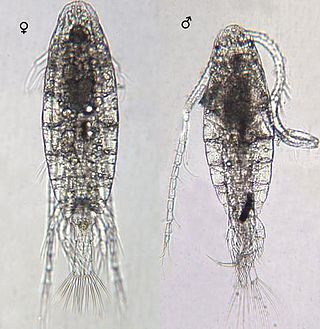Leptodiaptomus ashlandi
Species of crustacean From Wikipedia, the free encyclopedia
Leptodiaptomus ashlandi is a calanoid copepod zooplankton native to the Laurentian Great Lakes and their basin.
| Leptodiaptomus ashlandi | |
|---|---|
 | |
| Female and male L. ashlandi | |
| Scientific classification | |
| Domain: | Eukaryota |
| Kingdom: | Animalia |
| Phylum: | Arthropoda |
| Class: | Copepoda |
| Order: | Calanoida |
| Family: | Diaptomidae |
| Genus: | Leptodiaptomus |
| Species: | L. ashlandi |
| Binomial name | |
| Leptodiaptomus ashlandi (Marsh, 1893) | |
Distribution
Leptodiaptomus ashlandi is a zooplankton species widely distributed across Canada and the northern half of the United States in large deep lakes. It occurs in all the Great Lakes.[1]
Morphology
This article may be too technical for most readers to understand. (July 2014) |
Adult females of L. ashlandi can be distinguished by their two-segmented urosome and asymmetrical, rounded metasomal wings. Males are characterized by a large lateral spine on leg 5, located in the proximal third of the terminal segment, and by the presence of a slender process on the third segment from the distal end of the right antennule.[2] This species is morphologically similar to other leptodiaptomids (Leptodiaptomus minutus, L. sicilis) and skistodiaptomids (Skistodiaptomus oregonensis).
Ecology
Leptodiaptomus ashlandi are known prey items for a number of native and non-native Great Lakes fishes. They are also prey items for other invertebrate zooplankton. Remains have been found within gut-contents of Mysis diluviana[3] and are trophically below Limnocalanus macrurus.[4]
References
Wikiwand - on
Seamless Wikipedia browsing. On steroids.
